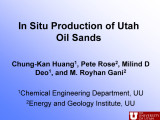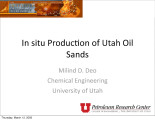TO
Filters: Collection: "ir_eua"
| Title | Date | Subject | Description | ||
|---|---|---|---|---|---|
| 1551 |
 |
Ignition in 40kw co-axial turbulent diffusion oxy-coal jet flames | 2010-08-08 | 40kw co-axial turbulent diffusion; diffusion; oxy-coal; oxy-coal jet flames; partial pressure of O2; coal transport | Outline: 1) Introduction 2) Objectives 3) Experimental setup 4) Methodology to quantify flame stability 5) Results and discussion 6) Conclusions 7) Acknowledgements. The objective of this presentation is to better understand, the effects of partial pressure of O2 in a) the coal transport jet, and b)... |
| 1552 |
 |
Immigrants transform Utah: entering a new era of diversity | 2004-05 | Utah is generally perceived as an extremely homogeneous state whose population can trace its ancestry mostly to northern Europe. Listings for surnames like Hansen, Jensen, and Christensen do fill many pages in local telephone directories throughout the state. According to census counts, the minority... | |
| 1553 |
 |
Impact of defense spending on the economy of Utah | 1967 | This report is a product of studies conducted at Utah State University under a contract with the Urban Renewal Administration of the Federal Housing and Home Finance Agency, under an arrangement worked out by Robert Huefner, Utah State Planning Coordinator. It builds upon The Defense Industry of Uta... | |
| 1554 |
 |
The impact of the intermountain power project on six counties in Utah | What will happen to the Utah economy when the largest industrial complex ever built in Utah is located in a sparasely populated rural area? The project in question is the four billion dollar Intermountain Power Project (IPP), a 3,000 megawatt, coal-fired electric power plant to provide electric powe... | ||
| 1555 |
 |
Impact of water recycle on water-based processing of Whiterocks tar sands | 1991-04 | Whiterocks tar sands; water-based processing; water recycle; hot water process for bitumen; bitumen recovery | Water recycle is an essential part of the hot water process for bitumen recovery from Utah tar sands. The current investigation was primarily designed to evaluate the direct recycle of process water after separation of coarse sand particles. Representative Whiterocks tar sand samples were used in al... |
| 1556 |
 |
The impacts of energy development in Eastern Utah | 1980-11 | The report was prepared by the Comprehensive Planning Section, State Planning Coordinator's Office under the direction of Paul Parker and Jeannie Watanabe. Population projections, and written narative were prepared by Brad Barber. Graphics were provided by Judith Banning. Secretarial services were p... | |
| 1557 |
 |
The implementation of composite computer mapping 1972 | 1972 | Composite computer mapping (CCM) is the name assigned to a recently developed technique to enhance the quality of decision making in the administration of aid to economic development. The name accurately implies a combination of two techniques (composite mapping and computer mapping) which have be... | |
| 1558 |
 |
The implementation of composite computer mapping for the four corners regional commission 1971 | 1971-12 | Composite computer mapping (CCM) is the name assigned to a recently developed technique to enhance the quality of decision making in the administration of aid to economic development. The name accurately implies a combination of two techniques which have been used with varying effectiveness for m... | |
| 1559 |
 |
Importance of bitumen viscosity in the hot water processing of domestic tar sands | 1983 | bitumen viscosity; hot water processing; domestic tar sands; bitumen recovery | The separation efficiency of the hot water digestionflotation technique used for bitumen recovery from various domestic tar sands was evaluated. Bitumen viscosity was found to be the most important tar sand property in determining the success of the bitumen separation. Bitumen viscosity of the tar s... |
| 1560 |
 |
In situ instrumentation: Final report of a joint EE/ME group study | 1974-10-25 | in situ instrumentation; EE/ME; fossil fuel; geothermal resources; in situ processing; oil shale; coal deposits; geothermal resources; measurements for energy process; instrumentation; instrumentation development; development costs | Greater utilization of our fossil fuel and geothermal resources is vital to our future national economic well-being. However, the economic utilization of oil shale, some coal deposits and geothermal resources may depend on in situ processing. In turn, the optimal development of in situ coal gasifica... |
| 1561 |
 |
In situ oil shale/sands group list | 2009-12-09 | Contact information for the in situ oil shale/sands group | |
| 1562 |
 |
In situ oil shale/sands thermal treatment hierarchy | 2009-11-04 | hierarchial chart; in situ oil shale/sands; thermal treatment research; liquid fuel production; in situ thermal treatment technologies | Hierarchical chart for the in situ oil shale/sands thermal treatment research area showing connectivity between subtasks. This chart helps illustrate the integration and focus among the subtasks needed to achieve liquid fuel production demonstrations of in situ thermal treatment technologies and als... |
| 1563 |
 |
In situ production of Utah oil sands | 2008-03-12 | in situ; Utah oil sands; oil sands production; tar sand deposits; Whiterocks eolian sandstone | |
| 1564 |
 |
In situ production of Utah oil sands | 2009-02-27 | in situ; oil sands production; Utah oil sands; in situ process; thermal simulator; thermal compositional model; steam assisted gravity drainage; SAGD; heterogenetics; in-situ combustion; hydraulic fracture; hybrid process | Analysis of issues relevant to in situ production of Utah oil sands, presented at the 2009 Western U.S. Oil Sands Conference by Milind Deo, Professor, Department of Chemical Engineering, University of Utah. |
| 1565 |
 |
In situ recovery of oil from Utah tar sand: A summary of tar sand research at the Laramie Energy Technology Center | 1985-10 | in situ recovery; oil recovery; Utah tar sand; tar sand research; Laramie Energy Technology Center; LETC; future recovery of oil; U.S. tar sands | Executive Summary: This report describes work done by the United States Department of Energy's Laramie Energy Technology Center (LETC) from 1971 through 1982 to develop technology for future recovery of oil from U.S. tar sands. Work was concentrated on major U.S. tar sand deposits that are found in ... |
| 1566 |
 |
In situ RF heating for oil sand and heavy-oil deposits | 1985-05 | in situ RF heating; oil sand; heavy-oil deposits; IITRI; energy efficiency; in situ radio-frequency heating process; oil shale; tar sand | Since the mid 1970s, IIT Research Institute (IITRI) has been developing an energy efficient, in situ radio-frequency (RF) heating process. Large blocks of oil shale or tar sand typically found in the Western United States have been emplanted with closely spaced electrodes and excited electromagnetic... |
| 1567 |
 |
In situ thermal processing of a coal formation to produce hydrocarbons having a selected carbon number range | 2004-06-15 | coal formation; coal; in situ; thermal processing; carbon | A coal formation may be treated using an in situ thermal process. A mixture of hydrocarbons, H2, and/or other formation fluids may be produced from the formation. Heat may be applied to the formation to raise a temperature of a portion of the formation to a pyrolysis temperature. An average temperat... |
| 1568 |
 |
In situ thermal processing of a coal formation using a controlled heating rate | 2004-06-15 | coal formation; in situ thermal process; in situ; thermal process; heating rate | A coal formation may be treated using an in situ thermal process. A mixture of hydrocarbons, H2, and/or other formation fluids may be produced from the formation. Heat may be applied to the formation to raise a temperature of a portion of the formation to a pyrolysis temperature. A heating rate to a... |
| 1569 |
 |
In-furnace capture of cadmium and other semi-volatile metals by sorbents | 2005 | in-furnace capture; cadmium capture; semi-volatile metals; sorbents; sorbent utilization | An 18 kW, cylindrical (inside diameter = 15-cm), 6-m high, laminar, downflow furnace was used to investigate the mechanisms governing reactive scavenging of cadmium vapors from combustion environments, by hydrated lime and kaolinite powder sorbents. Two major physical mechanisms dominate the reactio... |
| 1570 |
 |
In-situ combustion handbook--principles and practices | 1999-01 | in-situ combustion; oil reservoir; oil recovery; field trials; fireflood projects; combustion projects | For nearly 90 years in-situ combustion technique has been used in the U.S. in attempts to improve recovery from oil reservoirs. Despite its long history and commercial success of many field projects, the process has not found widespread acceptance among operators due to the excessive number of failu... |
| 1571 |
 |
In-situ production of Utah oil sands bitumen | 2007-11 | in situ production; Utah oil sands; Utah reservoirs; in situ bitumen production; SAGD; case studies | In-situ production of oil-sand bitumen offers an excellent alternative to the ex situ processes that are based on strip-mining and surface extraction. In addition to leaving the landscape relatively undisturbed, in situ processes allow for partial upgrading of oil sands, leaving heavier, less profit... |
| 1572 |
 |
Incipient fluidization characteristics of crushed oil shale | 1983-02-01 | incipient fluidization characteristics; oil shale; incipient fluidization; gas velocity; petroleum refining | We have measured the gas velocity for incipient fluidization of crushed shale as a function of particle size, particle-size distribution, shale grade, crushing method and temperature. This velocity varied as the square of particle size for 0.0063- to 0.1-cm particles ano approximately as the square ... |
| 1573 |
 |
Increasing Depth in UCG: Advantage or Disadvantage? | 2011-03-23 | well depth comparison; well depth; UCG; UCG reactor; UCG process module; process parameters; study cases | 6th Annual International Conference & Workshop on Underground Coal Gasification, 23rd - 24th March 2011 |
| 1574 |
 |
Increasing of UCG effectiveness by laboratory research | 2011-03-23 | UCG efectiveness; syngas quality; thermodynamics model; syngas composition; dynamic thermal model; syngas calorific value; syngas; experimental research | 6th Annual International Conference & Workshop on Underground Coal Gasification, 23rd - 24th March 2011 |
| 1575 |
 |
Index | Index for the Bulletin of the University of Utah |
